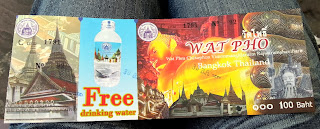When you visited The Grand Palace and Emerald Buddha, try not to miss out the next visit to Wat Pho (Reclining Buddha) which located within walking distance. When we went out from the main gate of The Grand Palace, the guard inform us to keep left and follow the white wall of The Grand Palace so that we could reach the Wat Pho. Of course, the guard was not misleading us but the 'walking distance' looks like too long, we took almost 15-20 minutes to walk to the temple. Don't know whether keep right would be better? Anyway, if you do not like to walk, just hop on the Tuk Tuk and let them bring you there.
Let's follow the arrow of the signboard above. Then it would bring you to the ticketing counter...haha..
The entrance fee is only 100 Baht, some more free us one small bottle of drinking water. The redeem counter is located after the entrance, but not necessary to redeem it immediately. Like us, after walking around under the hot sun, then only we redeem the cool drinking water, feeling so good ~
Ooo... out of topic already..Let's focus back our visit to the Reclining Buddha. Before we could enter the temple, we need to take off our shoes. But here did not have shoe rack..so how??? No issue, they prepare the shoe bag for each visitor..just put our shoe inside the bag and carry it during the visit. Although carried shoe bag was bit burden when we wanted to take photo, but it was good from the angle to ensure our shoe is secure..But remember to return the shoe bag after use ya.....
When we entered the temple, the sound 'wow' was everywhere...why?? Let see the photo below.
The Reclining Buddha is huge!!! Some more it is in gold color....
The Reclining Buddha is 15 meters high and 46 meters long, while each foot is 3 metered high and 5 meters long. The statue is made by stuccoed bricks that gilded with gold leaves.
The feet of Reclining Buddha is inlaid with mother-of-pearl, indicate 108 auspicious symbols portraying natural scenes of both Indian and Chinese influences.
The temple is having high ceiling and feeling cool compared to hot sun outside. The wall is with amazed mural painting. Along the path in front of the Reclining Buddha, we saw other small statue of Buddha. We allowed to take photo but please not to sit on the altar.
When we walked to the back of the Reclining Buddha, then we saw a counter with donation box. By donated 20 Baht, we were given a bowl of coins that allow us to place it into the 108 bronze bowls lining along the corridor. The 108 bronze bowls represent 108 auspicious characters of Buddha. Dropping the coins into the bronze bowls is believed to be able in bringing good luck to the visitors. If no conflict with your religion or believe, you may consider to experience it.
We were then left the temple and continue visit other structures within the compound of Wat Pho. We saw a beautiful pond with many carp fish inside. The decoration is very attractive.
Visitors are 'Welcome to Wat Po'.
Do you notice the huge pagodas behind? There are total 4 pagodas in a group and being named as Phra Maha Chedi Si Rajakarn. These four Pagodas were built to represent the reign of King Rama I to King Rama IV of the Chakri Dynasty. Each pagoda is 42 meters high and decorated with colourful mosaics. The green tile mosaic pagoda representing the reign of King Rama I, the white tile mosaic pagoda representing reign of King Rama II, the yellow tile mosaic pagoda representing reign of King Rama III and the dark blue tile mosaic pagoda representing reign of King Rama IV.
The King Rama IV had ordered to enclose all four pagodas and leave no spaces for other pagodas to build around, as these four Kings were alive and met each other in the same period of time, and no more pagodas was required.
Besides the four huge pagodas, there are also four groups of five pagodas that named as Single based Chedi. The big pagoda in the centre and surrounded by four small pagodas. Each pagoda contains the Holy Relics of Buddha and was constructed during reign of King Rama I.
 |
| Single base Chedi |
 |
| Phra Chedi Rai |
During our visit, there was a group of primary school students (I guess) who studied and doing assignment in this Wat Pho.
Last but not least, the Gate Guardian statues are very unique in this Wat Pho. The statues are in different design, from Chinese Warriors to Western Guard. Not to miss it for photographing.
In conclusion.....Remember to include Wat Pho in your visit plan ya!!!
Related Post
Bangkok 2013-Wat Arun (Temple of Dawn)
Bangkok 2013-The Grand Palace and Emerald Buddha Part II
Bangkok 2013-How to go to The Grand Palace and Emerald Buddha?




















































